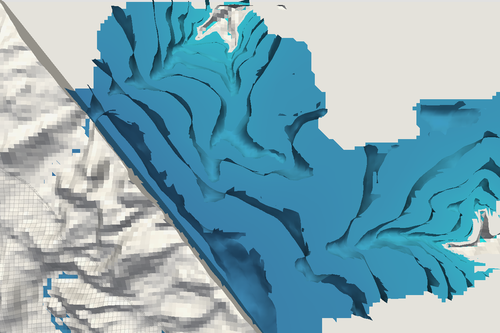Objectives
The development of the course will allow the application of groundwater modeling tools to analyze regional and local flow. Participants will learn to build model on MODFLOW 6 and analyze the results.
In this course the student will learn:
ModelMuse environment and tools for modeling.
Know the potential of Model Muse to build MODFLOW 6 models.
Conceptualization criteria, grid design and boundary conditions.
Modeling of particle tracking with MODPATH.
Calibration and transient simulation of numerical models.
Analyze water balances and head distributions.
Course content
Session 1: Introduction to MODFLOW 6
Development a basic model to familiarize with the construction and simulation of a steady state -MODFLOW 6 model and the visualization of hydraulic heads in ModelMuse.
Definition of model grid.
Setting of aquifer type (confined or unconfined) and hydraulic parameters.
Setting of boundary conditions: RCH, RIV and WEL.
Visualization of results and water balance.
Session 2: DISV Package and quadtree refinements
Model implemented with DISV (Discretization by Vertices) grid, which is a new feature incorporated in ModelMuse by the name of quadtree refined grid.
Construction of a steady-state model with quadtree refinement.
Definition of boundary conditions that represent a lake as a constant-head, a river and wells with different pumping rates.
Model run and water balance analysis.
Visualization of groundwater level.
Session 3: Advanced packages
A exercise focused in modeling the dynamic of the groundwater related in advanced stress packages like multi-aquifer wells (MAW) and stream-flow routing (SFR).
Construction of a model with advanced packages: MAW (Multi-Aquifer Well) and SFR (Stream Flow Routing).
Implementation of a lake as a constant head boundary
Simulation of a transient mode.
Session 4: Particle tracking
Developing of 2 examples on particle tracking with Modpath7 to see the movement of particles coming from a source.
Part 1:
Configuration of MODPATH in a steady-state model with quadtree refinement.
Forward and backward particle tracking simulation applied to a model with general-head boundary conditions and wells.
Part 2:
Configuration of MODPATH in a transient-state model.
Forward and backward particle tracking simulation applied to a model with wells with different pumping rates and a river that interacts with a nearby well
Session 5: Three-dimensional anisotropy
Configuration XT3D which enables a full 3d anisotropy in MODFLOW 6 models, this is applied trough angles in a 3D model.
Part 1:
Creation of a model in steady-state with three-dimensional anisotropy applied in 2 axis that creates whirls.
Insertion of wells pumping and injecting water in different layers.
Part 2:
Three-dimensional steady-state simulation with quadtree refinement and three-dimensional anisotropy distributed in 2 axis of the grid.
Session 6: Regional model
This session is focused to create a model for represent a regional groundwater model based on a basin, rivers and topography. Apart of that, we will develop the comparative of head observed and simulated.
Construction a three-dimensional steady-state model with a basin that delimits the active zone placed throughout the extension of the grid.
Use graphic objects and external shapefiles to apply to boundary conditions such as recharge, evapotranspiration, and rivers.
Application of head observations and post-processing of results with Python
Methodology / Examination
Mode: Online with streaming - Synchronous
Some details about the course methodology:
Manuals and files for the exercises will be delivered on our online platform.
The course will be developed by video streaming with life support and interaction, recorded videos will be available on our elearning platform.
There is online support for questions regarding the exercises developed through email and meet.
Video of the classes will be available for 2 months.
The exams are certification is organized as follows:
The course has 1 exam that comprise the content.
Digital certificate available at the end of the course upon the exam approval.
To receive the digital certificate you must submit the exam.
Date and time
October - 2022 (Central European Time (CET) - Amsterdam)
Monday 10, 2022 from 6:00 pm to 7:30 pm.
Wednesday 12, 2022 from 6:00 pm to 7:30 pm.
Monday 17, 2022 from 6:00 pm to 7:30 pm.
Wednesday 19, 2022 from 6:00 pm to 7:30 pm.
Monday 24, 2022 from 6:00 pm to 7:30 pm.
Wednesday 26, 2022 from 6:00 pm to 7:30 pm.
